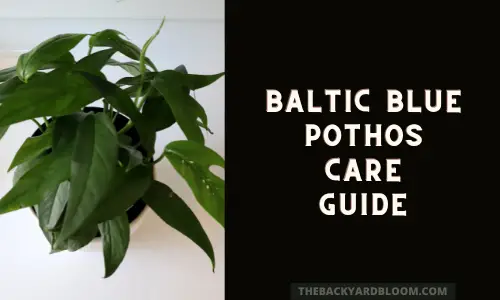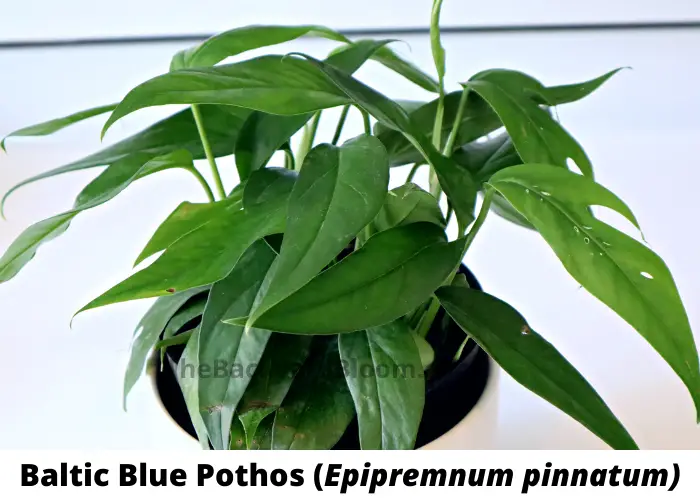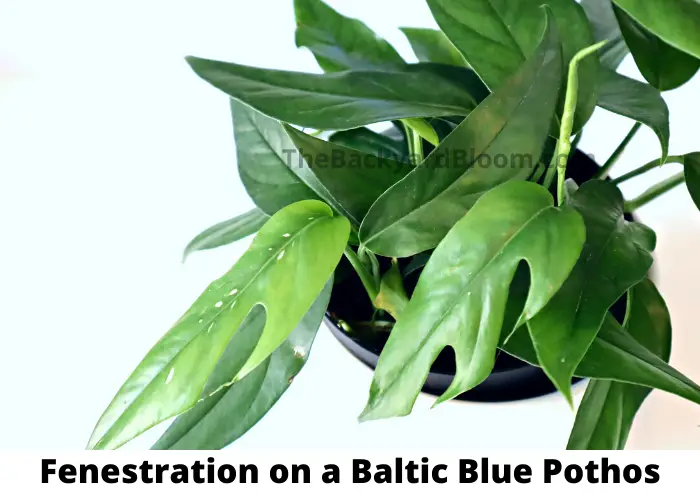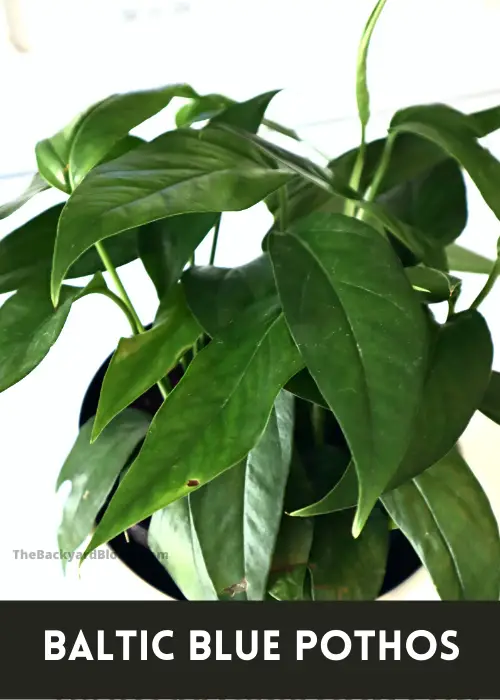Please note that this post may contain affiliate links. You can read my full affiliate disclosure at the bottom of the page.
The Baltic Blue has been making its way into big box stores over the last few months and it is fast becoming one of the highly popular and sought-after Pothos this year. They are known for their beautiful dark green leaves with blue undertones and the fenestrations that start to appear in the older leaves.
If you are one of the many Pothos lovers who has gotten your hands on a Baltic Blue Pothos lately you may be wondering “How do you take care of Baltic Blue Pothos?” Then this Baltic Blue Pothos care guide is just what you need.

Baltic Blue Pothos Origins
The Baltic Blue Pothos belongs to the Epipremnum genus. But unlike other common Pothos varieties that are Epipremnum aureum such as the Golden Pothos or Marble Queen Pothos, the Baltic Blue is an Epipremnum pinnatum. The Baltic Blue, while not documented as such, is probably a mutation found from the natural dark green Epipremnum pinnatum that was initially found in its natural habitat. As is the Cebu Blue Pothos.

Baltic Blue Pothos Scientific Name
- Epipremnum pinnatum ‘Baltic Blue‘
- Epipremnum pinnatum ‘Baltic Form‘
The Epipremnum pinnatum looks different from Epipremnum aureum. The leaves are longer and narrower in the Epipremnum pinnatum varieties of Pothos plants. They also have fenestrations (holes and openings in the leaves) that can start to appear on mature older leaves. These fenestrations can sometimes cause some varieties of the Epipremnum pinnatum to be confused with the Monstera genus.
The Epipremnum pinnatum was found in the Phillippines and documented by botanists in 1908. They are naturally found in dense rain forests. They are a climbing plant that will climb up other trees in the rain forest, up to 50 feet sometimes.
Even though this is a plant that naturally climbs, you can have your Baltic Blue grow as a trailing or provide it with something to climb.
Is the Baltic Blue Pothos Rare?
While not as rare as some other Pothos varieties, the Baltic Blue definitely is not a common Pothos to find in stores. It is a newer type of Pothos to become available and as it gains more popularity it will become easier to find.
Other Pothos Care Guides:
- Neon Pothos Care Guide
- N’Joy Pothos Care Guide
- Global Green Pothos Care
- Cebu Blue Pothos Care
- Pothos Plant Care
- Pearls and Jade Pothos Care Guide
- Manjula Pothos Care Guide
- Golden Pothos Care Guide
- Marble Queen Pothos Care
- Jade Pothos Care Guide
Where to find Baltic Blue Pothos For Sale
There are multiple places you can find the Baltic Blue Pothos for sale. Big box stores are starting to get them in stock. Walmart currently lists them on its website.
There are online options too, Etsy is a popular place to find houseplants including the Baltic Blue. Costa Farms also allows you to purchase the Baltic Blue online and have it delivered.
Baltic Blue Pothos Care
The care for a Baltic Blue Pothos doesn’t defer too much from other types of Pothos plants:
- Bright indirect light
- Well draining soil
- Water once the soil has mostly dried out
- Don’t allow the temperature to drop below 55°F
- Fertilize twice a year
- Repot as needed only going up one pot size at a time
- Can adapt to humidity levels as they change, prefers humidity > 40%
- Keep out of the reach of pets, can be toxic to both cats and dogs
Baltic Blue Pothos Fenestration
Baltic Blue Pothos are known for their fenestrations in their leaves. Along with the beautiful blue hues, the fenestrations are what makes them so striking.

The leaves get fenestrations once they have matured. Providing bright indirect light helps the plant get more fenestrations. Another way to increase them is to give the plant something to climb up instead of letting the vines trail.
Baltic Blue Pothos Light Requirements
The best light for a Baltic Blue Pothos is indirect bright light. This will lead to better coloring and more of the blueish undertones that this Pothos is known for. Bright light will also help the leaves mature and get more of the beautiful fenestrations on their older leaves.
They can also grow well in a medium-light setting, but there will not be as much of a noticeable blue hue to the leaves and they will have less fenestration.
Do not let the plant sit in direct sunlight. Always filter any direct sunlight coming through the window. Exposure to the sun’s rays directly, even through a window can lead to burns on the leaves. Also, keep this in mind if you take your Baltic Blue outside during the warmer months. Keep it in a shaded area, or in an area that only gets the early morning sun.
Water Requirements
Allow most of the soil to dry out before watering your Baltic Blue Pothos. If the leaves start to droop slightly and the soil is dry to the touch then it is time to water your plant.
Overwatered Pothos can get root rot easily so you want to pay attention to how your Pothos looks to see if it is showing signs of being overwatered or underwatered.
Baltic Blue Pothos Soil
Like other Pothos plants, the Baltic Blue needs a well-draining soil.
A standard houseplant potting mix with additional perlite added to it will work well for these plants. If the soil is too dense it will not allow the water to drain well and the roots will become waterlogged and start to get root rot.

Repotting
Pothos plants, including the Baltic Blue, don’t need to be repotted too often. Only about once every year or two, depending on how fast it is growing.
When you do repot your Pothos, make sure to pick out a pot that allows for drainage. Without drainage in the pot, the roots will become waterlogged due to sitting in soggy soil. This can lead to root rot just as overwatering can.
If you start to see roots growing out of drainage holes in the bottom of your pot, then that is a good sign that the plant needs a bigger pot. Also if roots start to appear at the top of the soil in the pot, this is another sign that it has outgrown its pot.
Pick a pot that is an inch or two bigger in diameter than the current pot it is in. You do not want to increase the size of the pot it is in drastically.
When removing your plant from its current pot it is a good idea to remove as much of the old soil from the root ball as possible. Inspect the roots to make sure there are no damaged or diseased roots, remove any with some scissors or shears if you find them. Add new potting soil mix to the pot and replant your Baltic Blue in its new bigger pot.
Give it a good watering once done and let it dry out completely before watering it a second time after repotting.
Fertilizer
Baltic Blue Pothos don’t need much fertilizer. Fertilizing them twice a year, once in the Spring and again in the Summer, using a liquid houseplant fertilizer at half strength is enough for these plants.
I also like to do monthly watering with Fish Fertilizer, all of my houseplants seem to love this special watering.
Temperature
Baltic Blue Pothos, like other Pothos plants, do well inside with house temperatures between 60°F and 85°F.
If you live in a mild climate and put your Pothos outside, don’t leave it outside if the temperatures go below 55°F. Pothos are a tropical plant and don’t tolerate cool temperatures well.
Humidity
Ideal humidity levels for a Baltic Blue Pothos are above 40%. But like other Pothos they can handle lower humidity levels for periods of time, especially during the winter months. But they thrive in higher humidity levels.
You will also find that that humidity level will affect how much water your plant needs. If the humidity is lower, you will have to water the plant more frequently than if you have higher humidity levels.
Baltic Blue Pothos Propagation
Baltic Blue Pothos are easy to propagate, just like all of the other pothos.
You can propagate them through cuttings and use either water or soil to get roots to grow from the cuttings.
Check out our post on How to Propagate a Pothos in Water to see the steps needed to propagate a Baltic Blue.
Baltic Blue Pothos Toxicity and Pets
The ASPCA specifically lists Golden Pothos and Devils Ivy as poisonous to pets, so it is a safe bet to assume that all Pothos plants, including the Baltic Blue, are toxic to both dogs and cats.
If you have pets it is best to keep your pothos plants up high and out of reach of your animals.
There are products you can use to help deter your pet from chewing on your plant’s leaves. You can make your own citrus spray or there are commercial products such as Bitter Apple that you can use to make the plant smell and taste bad.
References:
- Epipremnum pinnatum (L.) Engl.; The Exotic Rainforest; http://www.exoticrainforest.com/Epipremnum%20pinnatum%20pc.html
- Golden Pothos; ASPCA; https://www.aspca.org/pet-care/animal-poison-control/toxic-and-non-toxic-plants/golden-pothos
- Devils Ivy; ASPCA; https://www.aspca.org/pet-care/animal-poison-control/toxic-and-non-toxic-plants/devils-ivy
Related Article for “Baltic Blue Pothos Care Guide”:
- How to Make a Pothos Grow Faster
- Why Do My Pothos’ Leaves Feel Soft?
- How To Dry Out an Overwatered Pothos